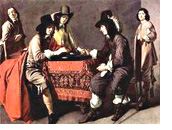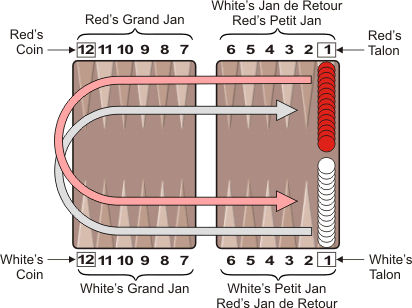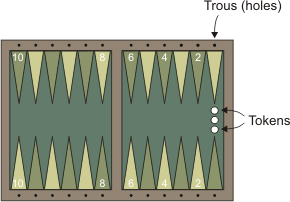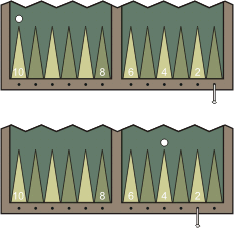![[Backgammon Galore!]](/gif/GaloreButton.gif)
|
|
Backgammon Variants  Many modern backgammon books refer to Trictrac simply as the French name for backgammon, however real Trictrac is quite a different game. Many modern backgammon books refer to Trictrac simply as the French name for backgammon, however real Trictrac is quite a different game.
Trictrac was invented in France about 1500. Over the years, a several important changes were made to the rules. And by the time of Louis XIV, the game had evolved into two separate games, known as le Petit Trictrac and le Grand Trictrac. Trictrac remained popular in France until the middle of the nineteenth century. The equipment is much the same as in backgammon. Players have fifteen checkers each which they move around the board according to rolls of the dice. However, unlike backgammon, racing plays only a small role in Trictrac. Setup: All fifteen checkers for both players start on that player's talon and move toward his coin de repos (coin), then around the board to the player's jan de retour where the checkers are borne off.
Object: The object of the game is to score points for different plays or different configurations of checkers as described below. Twelve points make one trou (hole), and twelve trous make one match. Start: Each player rolls one die and the player rolling higher goes first. That player then rolls two dice to begin his first turn. Movement: Movement is similar to backgammon except that doubles are played just once each and there is no hitting. Unlike in backgammon, if you touch a checker, your opponent can force you to play it. The roll of the dice indicates how many points, or pips, the player is to move his checkers. The following rules apply:
There is no actual hitting in this game, however the potential to hit an opposing checker scores points. Filling tables: If you have at least two checkers on each of the six points in your petit jan, grand jan, or jan de retour, you are said to fill that table. (You cannot fill the opponent's grand jan because you cannot occupy the opponent's coin.) If your roll allows you to fill a table, you must. And once having filled a table, you must preserve the table as long as possible. A checker may not stop on a point in the opponent's grand jan or petit jan if the opponent is still able to fill it. Bearing Off: Once you have moved all fifteen of your checkers into your jan de retour, you may begin bearing off. You bear off a checker by rolling a number that corresponds to the point on which the checker resides, and then removing that checker from the board. If there is no checker on the point indicated by the roll, then you must make a legal move using a checker on a higher-numbered point. If there are no checkers on higher-numbered points, you must remove a checker from the highest point that has a checker. Scoring: At each turn, you roll the dice and look to see which ways your roll might be used. These are the possible ways to score points.
Marking the score: A Trictrac board has twelve holes along the base of each side of the board used for scoring. For every twelve points a player scores, he moves a peg along the holes on his side of the board. When the peg reaches the hole at the base of the coin, the match is over.
Three small tokens are used to record points. The tokens start between the talons to indicate no points have been scored. As a player acquires points, he moves a token to the tip of a triangle on the board as follows: the second triangle represents 2 points, the fourth triangle represents 4 points, the sixth triangle represents 6 points, the seventh triangle represents 8 points, and the twelveth triangle represents 10 points. When a player accumulates twelve points, the token goes back to the talon and a trou is scored by moving the peg to a new hole.
If you score a trou on your own roll, you may either:
That is the purpose of the third token. If one player scores first, moving his token forward, and then the other player scores, the second player can still win a trou bredouille. So he uses two tokens to mark his score. If the first player scores again, he will return one of the second player's tokens back to the talon to indicate that trou bredouille is no longer possible. Ecoles: You must mark your score before making your move. If you omit counting any score or claim one wrongly, the opponent takes that score. This is called an école. The scoring of écoles is not obliged, but if you score an école you must score it totally. After all the scores have been credited, the player makes his move and it is the opponent's turn. For a more complete description of the rules, see David Levy's page, Rules for the Game of Trictrac. Thank you to Philippe Lalanne for his helpful corrections and explanations.
ReferencesBooks
|
![]()
Backgammon Galore : Variants



